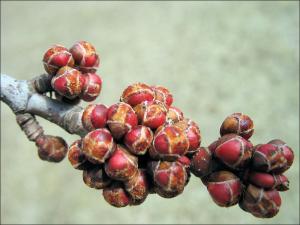Written by: John Wayne Farber, Board Certified Master Arborist (BCMA) WI-0877B, Certified Treecare Safety Professional 01462
When the days get longer and the temperature gets warmer, it means spring in Wisconsin. The first spring tree indicator I look for is silver maple flowers. The little red ball shaped buds begin to open and expose their tiny flowers before most other trees are even thinking about spring. Some people may be surprised to think about silver maple flowers as they are not large or showy, but all angiosperms flower. Angiosperms are broad-leafed plants and account for about 80% of tree species.
How Trees Know When To Grow
I like to draw parallels between tree and human behavior as we share common ancestry and it is easier to wrap our heads around concepts we are familiar with. But trees don’t operate on a calendar or at least the ones we are familiar with. They don’t say, “Hey it's May, time to leaf out.” Instead trees have special cells that monitor the light-to-dark ratio. When sufficient light is detected, the light receptors will tell other tree organs to start spring growth.
Temperature is also a factor. Much like us they don’t want to expose their sensitive parts to cold temperatures. Before trees break bud, they count the accumulated temperature over time. When a sufficient number of days above freezing occurs, trees are ready to put on new growth. Unfortunately, trees are not as good at forecasting weather conditions as we are. This temperature mechanism can cause some trees to begin to grow, and when an unexpected frost hits the new growth will die back. Spring dieback as a result of a late frost will cost the tree valuable energy, but as long as the tree is healthy it will likely survive and push out more new growth.
Climate change also plays into tree behavior. When the timing of elongated light becomes out of sync with the warming temperatures, trees struggle to adapt. Humans can layer on clothing or get up and move but once a tree decides it is spring and begins to grow it is all or nothing.
Where Growth Occurs in Trees
Primary tree growth is initiated at the tips of the branches at a location called the apical meristem. In the prior autumn season, the tree prepared a terminal bud at the furthest tip, with all the parts and energy required for spring elongation. A regulating plant growth hormone called Auxin, located in the terminal bud, keeps the rest of the tree from growing at this time. Once the furthest tips have started to elongate it releases the rest of the branch so it can do the same. This is the reason why trees grow up and out and not just into a dense ball of foliage.
After the branches have grown, the tree goes through secondary growth in expanding the circumference of the trunk. This growth is located at the vascular cambium, a layer of dividing cells around the stem. The tree puts on this growth from a small band of cells which produce xylem, water-moving tissue, to the inside and phloem, sugar-moving tissue, to the outside. In some trees this can easily increase the diameter of a tree by an inch or more a year.

Trees are as unique as people. For optimal health people visit a doctor regularly. I suggest the same for your trees. Regular checkups and prevention of issues will have the best health outcomes for your trees. Spring is a great time to get that checkup.
You can request a tree and shrub inspection by one of our certified arborists by contacting Hoppe at 414.257.2111.







Comments